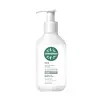What's inside
What's inside
 Key Ingredients
Key Ingredients

 Benefits
Benefits

 Concerns
Concerns

 Ingredients Side-by-side
Ingredients Side-by-side

Water
Skin ConditioningDisodium Cocoamphodiacetate
CleansingCarthamus Tinctorius Seed Oil
MaskingGlycerin
HumectantCocamidopropyl Betaine
CleansingCaprylyl Glycol
EmollientAcrylates/C10-30 Alkyl Acrylate Crosspolymer
Emulsion StabilisingPanthenol
Skin ConditioningSesamum Indicum Seed Oil
EmollientCaprylic/Capric Triglyceride
MaskingStearic Acid
CleansingAvena Sativa Kernel Flour
AbrasiveXanthan Gum
EmulsifyingAminomethyl Propanol
BufferingCaprylhydroxamic Acid
Rosa Canina Fruit Oil
EmollientTocopherol
AntioxidantCetearyl Alcohol
EmollientGlycine Soja Oil
EmollientBeta-Glucan
Skin ConditioningSodium Hyaluronate Crosspolymer
HumectantCitric Acid
BufferingWater, Disodium Cocoamphodiacetate, Carthamus Tinctorius Seed Oil, Glycerin, Cocamidopropyl Betaine, Caprylyl Glycol, Acrylates/C10-30 Alkyl Acrylate Crosspolymer, Panthenol, Sesamum Indicum Seed Oil, Caprylic/Capric Triglyceride, Stearic Acid, Avena Sativa Kernel Flour, Xanthan Gum, Aminomethyl Propanol, Caprylhydroxamic Acid, Rosa Canina Fruit Oil, Tocopherol, Cetearyl Alcohol, Glycine Soja Oil, Beta-Glucan, Sodium Hyaluronate Crosspolymer, Citric Acid
Water
Skin ConditioningDisodium Cocoamphodiacetate
CleansingGlycerin
HumectantSodium Lauroyl Sarcosinate
CleansingGuar Hydroxypropyltrimonium Chloride
Skin ConditioningCocamidopropyl Betaine
CleansingAvena Sativa Kernel Flour
AbrasivePentylene Glycol
Skin ConditioningSodium Lactate
BufferingLactic Acid
BufferingSerine
MaskingBeta-Glucan
Skin ConditioningUrea
BufferingAloe Barbadensis Leaf Juice
Skin ConditioningSorbitol
HumectantSodium Chloride
MaskingAllantoin
Skin ConditioningPhenoxyethanol
PreservativeCaprylyl Glycol
EmollientSorbic Acid
PreservativeBenzyl Alcohol
PerfumingCitric Acid
BufferingWater, Disodium Cocoamphodiacetate, Glycerin, Sodium Lauroyl Sarcosinate, Guar Hydroxypropyltrimonium Chloride, Cocamidopropyl Betaine, Avena Sativa Kernel Flour, Pentylene Glycol, Sodium Lactate, Lactic Acid, Serine, Beta-Glucan, Urea, Aloe Barbadensis Leaf Juice, Sorbitol, Sodium Chloride, Allantoin, Phenoxyethanol, Caprylyl Glycol, Sorbic Acid, Benzyl Alcohol, Citric Acid
Ingredients Explained
These ingredients are found in both products.
Ingredients higher up in an ingredient list are typically present in a larger amount.
Oatmeal flour is created by grinding down the kernels of oats. Oatmeal helps sooth, hydrate, and protect the skin.
Oatmeal kernel flour has abrasive, or exfoliating, properties.
Learn all about the skin benefits of colloidal oatmeal here.
Learn more about Avena Sativa Kernel FlourBeta-Glucan is a polysaccharide. It can be derived from the cell walls of seaweed, oats, yeast, and fungi. It hydrates the skin and helps boost your skin's natural barrier.
As an antioxidant, beta-glucan helps fight free-radicals. Free-radicals are molecules that may damage your skin cells, such as pollution.
Studies show this ingredient may be an effective wrinkle reducer as it can deeply penetrate into skin. It has also been show to help with wound healing.
Learn more about Beta-GlucanCaprylyl Glycol is a humectant and emollient, meaning it attracts and preserves moisture.
It is a common ingredient in many products, especially those designed to hydrate skin. The primary benefits are retaining moisture, skin softening, and promoting a healthy skin barrier.
Though Caprylyl Glycol is an alcohol derived from fatty acids, it is not the kind that can dry out skin.
This ingredient is also used as a preservative to extend the life of products. It has slight antimicrobial properties.
Learn more about Caprylyl GlycolCitric Acid is an alpha hydroxy acid (AHA) naturally found in citrus fruits like oranges, lemons, and limes.
Like other AHAs, citric acid can exfoliate skin by breaking down the bonds that hold dead skin cells together. This helps reveal smoother and brighter skin underneath.
However, this exfoliating effect only happens at high concentrations (20%) which can be hard to find in cosmetic products.
Due to this, citric acid is usually included in small amounts as a pH adjuster. This helps keep products slightly more acidic and compatible with skin's natural pH.
In skincare formulas, citric acid can:
While it can provide some skin benefits, research shows lactic acid and glycolic acid are generally more effective and less irritating exfoliants.
Most citric acid used in skincare today is made by fermenting sugars (usually from molasses). This synthetic version is identical to the natural citrus form but easier to stabilize and use in formulations.
Read more about some other popular AHA's here:
Learn more about Citric AcidCocamidopropyl Betaine is a fatty acid created by mixing similar compounds in coconut oil and dimethylaminopropylamine, a compound with two amino groups.
This ingredient is a surfactant and cleanser. It helps gather the dirt, pollutants, and other impurities in your skin to be washed away. It also helps thicken a product and make the texture more creamy.
Being created from coconut oil means Cocamidopropyl Betaine is hydrating for the skin.
While Cocamidopropyl Betaine was believed to be an allergen, a study from 2012 disproved this. It found two compounds in unpure Cocamidopropyl Betaine to be the irritants: aminoamide and 3-dimethylaminopropylamine. High-grade and pure Cocamidopropyl Betaine did not induce allergic reactions during this study.
Learn more about Cocamidopropyl BetaineDisodium Cocoamphodiacetate is a surfactant and helps cleanse skin. It is created from the fatty acids of coconut oil.
Surfactants help rinse oil, dirt, and other pollutants easily from skin. It has a faint fruit-like scent.
Glycerin is already naturally found in your skin. It helps moisturize and protect your skin.
A study from 2016 found glycerin to be more effective as a humectant than AHAs and hyaluronic acid.
As a humectant, it helps the skin stay hydrated by pulling moisture to your skin. The low molecular weight of glycerin allows it to pull moisture into the deeper layers of your skin.
Hydrated skin improves your skin barrier; Your skin barrier helps protect against irritants and bacteria.
Glycerin has also been found to have antimicrobial and antiviral properties. Due to these properties, glycerin is often used in wound and burn treatments.
In cosmetics, glycerin is usually derived from plants such as soybean or palm. However, it can also be sourced from animals, such as tallow or animal fat.
This ingredient is organic, colorless, odorless, and non-toxic.
Glycerin is the name for this ingredient in American English. British English uses Glycerol/Glycerine.
Learn more about GlycerinWater. It's the most common cosmetic ingredient of all. You'll usually see it at the top of ingredient lists, meaning that it makes up the largest part of the product.
So why is it so popular? Water most often acts as a solvent - this means that it helps dissolve other ingredients into the formulation.
You'll also recognize water as that liquid we all need to stay alive. If you see this, drink a glass of water. Stay hydrated!
Learn more about Water